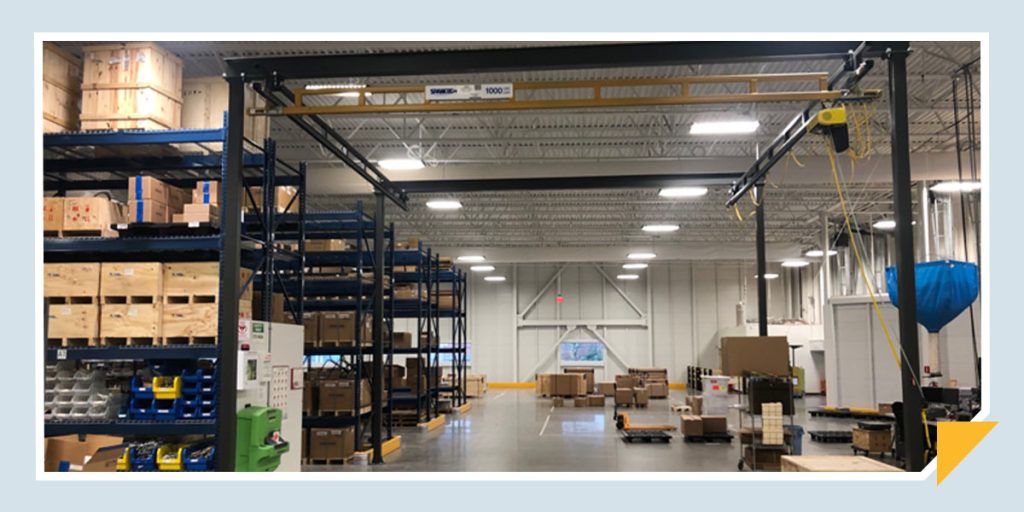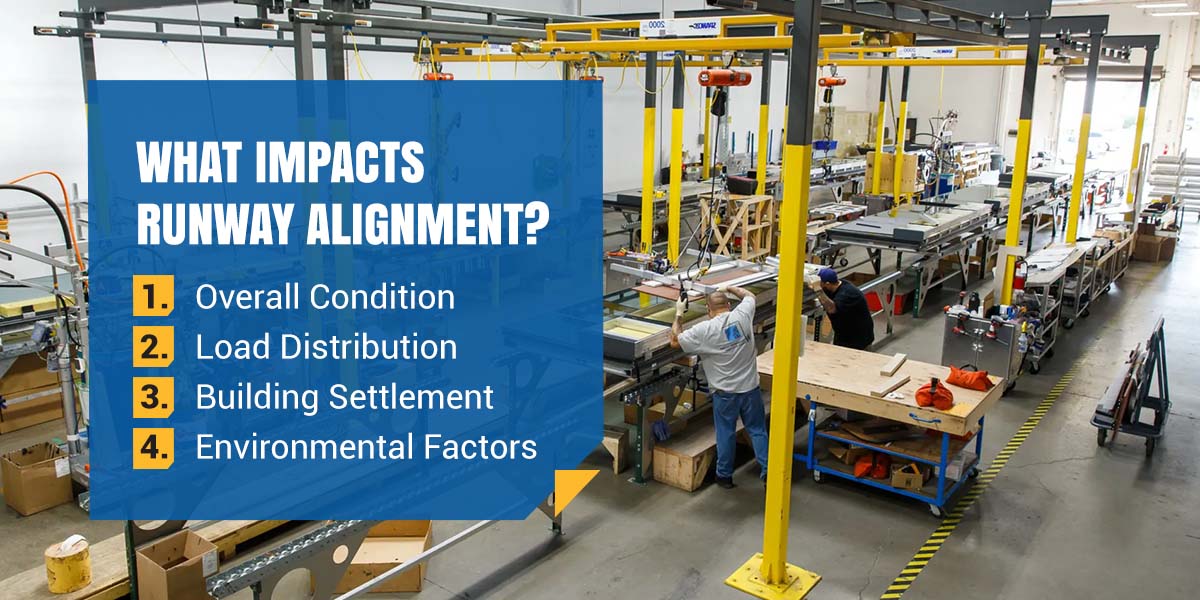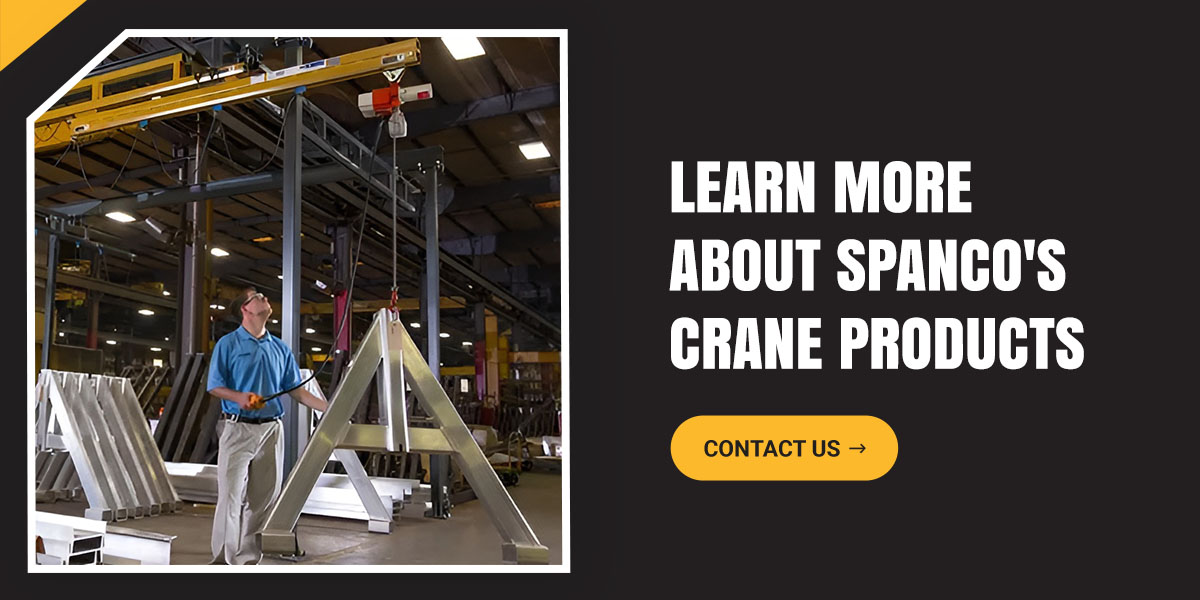
Are Your Runways Aligned?
Dec 20, 2024
Proper crane runway alignment is crucial to meeting performance requirements and ensuring safe, efficient operations. End users must ensure that crane tolerances are within the specifications outlined by the Crane Manufacturers Association of America (CMAA). Key factors to monitor include elevation levels, spans, straightness, and runway clearances.
Why Is Proper Runway Alignment Imperative?
Aligned runways help ensure safety, efficiency, and effectiveness so that your operations move forward as expected. Poor alignment can cause excessive stress on the runway and building structures, resulting in crane racking, skewing, or binding. Wear on crane components, such as wheels and brakes, can put additional strain on motors and other system parts. Alignment directly affects the crane’s life span and efficiency.
How Can You Tell if You Have Poor Crane Rail Alignment?
You may have poor rail alignment if you notice the following warning signs:
- Loud sounds, such as cracking noises, during operations
- Cracked wheel flanges
- Increased power requirements to move the crane system through the runway
- Abnormal rail, wheel, or wheel bearing deterioration
- Wheels that appear to float or climb over the rail
It is possible that the crane will run silently and not show any other obvious misalignment signs. Because misalignment can create excessive strain on your equipment and building structures, call in an expert who can identify issues and perform a full runway analysis.
CMAA Crane Runway Alignment Requirements
CMAA outlines specifications for runways. While these guidelines are advisory and not mandatory, they are widely accepted and promote long-lasting performance. CMAA Specifications No. 70 and No. 74 state that runways must be straight, parallel, level, and at the same elevation. These factors are critical to optimal crane performance with minimal wear. The main specifications associated with these four factors include:
- Runways must be aligned in the four factors to (±) 1/4-inch in a single bay.
- Runways must be aligned (±) 3/8-inch over the full runway length.
Let’s look at overhead crane rail alignment requirements for runway span, elevation, straightness, and clearance more in-depth.
Runway Span
The runway span must be within tolerances to prevent premature wear and racking. Runway span specifications include:
- Spans less than 50 feet are allowed a 3/16-inch tolerance.
- Spans 50 to 100 feet are allowed a ¼-inch tolerance.
- Spans more than 100 feet are allowed a 3/8-inch tolerance.
The requirements allow for a maximum rate of change of ¼-inch for every 20 feet of runway. Exceeding these tolerances can lead to racking and faster component deterioration. Appropriate span distances reduce strain and promote system longevity.
Runway Elevation
Runway elevation should be within 3/8 inches on each runway. For cranes spanning less than 50 feet, rail-to-rail elevation should be within 3/16 inches. For larger cranes — spanning 50 to 100 feet — rail-to-rail elevation should be within 1/4-inch. A 3/8-inch tolerance is acceptable for cranes spanning more than 100 feet. Similar to crane span specifications, the maximum rate of change for elevation is 1/4-inch for every 20 feet of runway.
Runway Straightness
How straight your runway is depends on the space between rails. CMAA standards say each rail can vary 3/8 inches from the center. CMAA maintains this specification regardless of rail size.
Horizontal and Vertical Clearances
CMAA and the Occupational Safety and Health Administration (OSHA) require all moving objects, such as cranes and hoists, to remain clear of all stationary objects, such as building structures. OSHA suggests avoiding interference by installing cranes and hoists to clear all horizontal stationary objects by 2 inches and all vertical objects, such as roof trusses, lights, or pipes, by 3 inches.

What Impacts Runway Alignment?
Many factors can cause runways to become improperly aligned, including condition and age, load distribution, foundational settling, and environmental forces.
1. Overall Condition
Your crane’s runway is the foundation for your crane system, so it needs to be in optimal condition to ensure excellent performance. Aging and corroded runways can distort the runway structure and lead to premature wear. Identify and resolve wear and tear issues through regular maintenance and inspections to extend your crane system’s life span.
2. Load Distribution
Uneven load distribution on the crane runway can cause structural deformations that lead to misalignment. If the crane consistently lifts loads from the same location, rails can overload and start to bend or sag. Planning loads and rotating crane locations can help improve distribution and minimize wear and misalignment.
3. Building Settlement
As a building’s foundation settles due to soil compaction or moisture content changes, it can impact interior structures and cause runways to become misaligned. If foundation components settle at varying rates, it will provide uneven support to the crane runway, causing bending, warping, or unbalanced load distribution. Regular inspections can reveal foundational settling and opportunities to level and realign crane systems.
4. Environmental Factors
Crane runway alignment can change depending on environmental factors like:
- Temperature fluctuations that cause the metal to expand and contract.
- Increased moisture that can saturate the soil and accelerate uneven foundational settling.
- Seismic activity that impacts structural stability.
- Vibrations from nearby operations, machinery, or construction that gradually misalign runways.
Mitigate risks by learning about the environment in which your crane operates. Conduct regular inspections and maintenance procedures to ensure structural stability and safety.
What Does a Crane Rail Alignment Survey Entail?
An alignment survey promotes proper runway alignment to minimize damage and extend equipment life spans. Several factors can impact runway alignment, so it’s a good idea to watch for any unusual sounds or signs of racking. Conduct regular visual inspections and create a schedule for periodic and annual maintenance to ensure your runway remains in good condition. Check your runway system after a significant event, such as a natural disaster or an extreme temperature change, to catch any potential issues early.
Contact a qualified inspector who can perform an alignment survey and check for any discrepancies. These professionals can leverage technology, such as laser equipment, to perform quick and accurate inspections. Technicians can test and correct your runways quickly and easily, ensuring your crane is operational with minimal downtime.

Learn More About Spanco’s Crane Products
Spanco is proud to be a leading American manufacturer of workstation bridge cranes, jib cranes, overhead gantry cranes, and monorail cranes. When you partner with us, you will benefit from our extensive experience, expertise, and resources. Our team is here to help you select the best material-handling equipment for your facility.
Contact us to learn more about our products and how we prioritize crane alignment during manufacturing. Find a representative near you if you have any questions!
Categories
Share this post
Contact us
Looking for the perfect fall protection equipment? Let us help!
